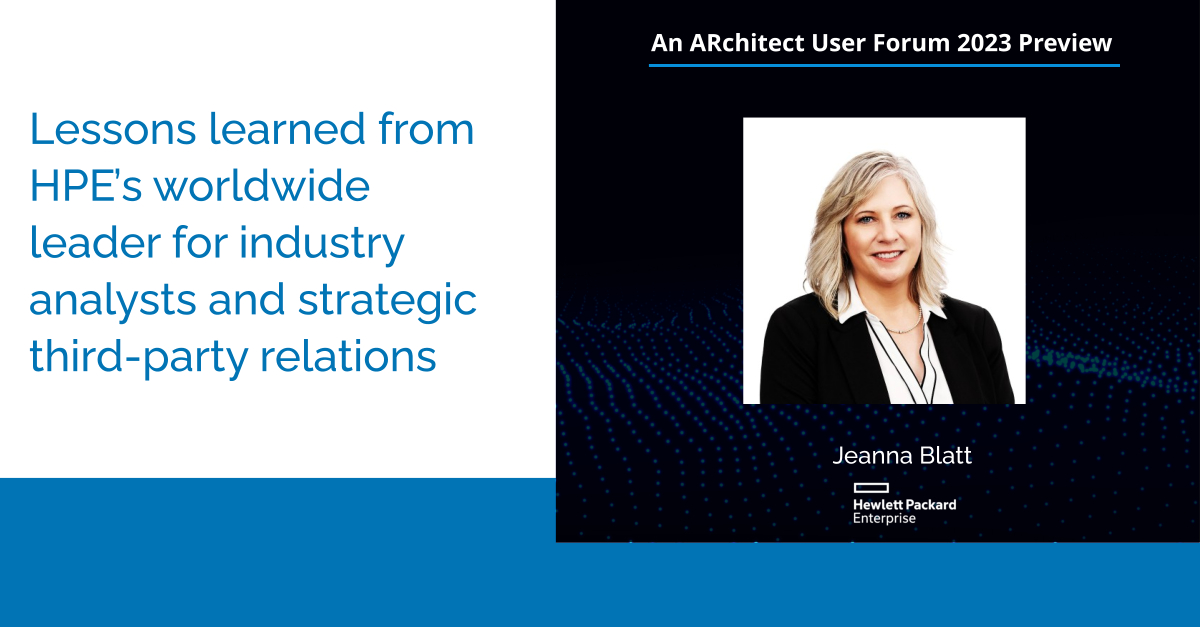We’re excited to launch “Profiles in AR,” a new series on the ARInsights blog. These Q&A-style interviews will bring you fresh insights, real-world anecdotes and actionable advice from people who are immersed in the fabric of analyst relations (AR).
From accomplished, interesting and expert practitioners, to highly regarded analysts themselves, they’ll say it best, and tell it like it is! We’ve got a great line-up for you.
Kicking off the series is Robin Schaffer, a well-known AR expert, the founder and principal of analyst relations consultancy Schaffer AR, and the author of Analysts on Analyst Relations. Described as “an absolute force of nature in the world of analyst relations,” Robin has practiced AR for the last 15 years. We were thrilled for the opportunity to chat with her about her experiences.
Read on for Robin’s thoughts on the nature of AR, where the field is headed and much more.
Q: If you had to describe AR in three adjectives, what would they be?
Robin: Can I hyphenate to fit more in? I’d say perennially-challenging, super-interesting and in-the-thick-of-things.
What I mean by the last one is that with AR, you’re representing the core of the business, and it puts you in the center of many different activities. That’s an exciting place to be! You’re at the crossroads of really important relationships and know a lot about what’s going on in the company.
Q: We’d love to hear about your career journey. What led you to analyst relations?
Robin: That’s a fabulous question because, as you meet and talk to AR people of all types, you learn that almost nobody decided to be in analyst relations! No one went to school for it or set off on that career path. We laugh about the fact that we all just kind of came upon it — which is a really interesting point on its own.
As for me, I came to AR after being in B2B marketing for a long time. That was my first job out of college, and, over the years, I held many B2B marketing roles: from very strategic, to very tactical, and everything in between.
And then about 15 years ago, when I was working at a medium-sized technology company, they came to me and said, “Can you start up an AR program for us?”
I was tempted to joke, “What does AR stand for, again?” I mean, I did know what it was, but I had no real background in it. From what I knew, though, it sounded interesting, so I said, “Sure, I’ll take that on.”
Once I got into AR, I loved it, and the rest is history. I immediately felt like my background served me well and helped me take a strategic approach — because AR should be very strategic and highly impactful. I worked in AR positions, long-term, for three different vendors in-house.
Then two years ago, I decided to hang out my shingle and start my own consultancy. So today, I work both with companies that already have analyst relations programs and need extra assistance, as well as — near to my heart — start-ups and scale-ups without AR programs yet. They are often too small to justify an in-house role, and working with an outside specialist makes the most sense for them. I just love the potential of taking AR and leveraging it to help their businesses in a tangible way.
Q: Can you tell us more about your work at Schaffer AR?
Robin: Sure. I have a great team that I work with; I love them! We give clients a holistic AR plan that uses all our different resources:
- I lead AR strategy across our accounts — helping align AR goals with business ones, creating plans to achieve those goals, and overseeing the team’s day-to-day work to make sure our activities reflect the “big picture.”
- Another team member, an AR expert, is our primary execution person — facilitating engagements and synthesizing notes, extracting insights from calls, coordinating follow-up, etc. These are all things that have to be done in the context of program goals — and, of course, done with quality.
- We also have a really talented support person. She helps our AR expert in execution and specializes in project management, because as you know, in AR, it’s critical to keep track of all the moving parts. She also does a lot of research, like when we have a new account and want to identify relevant analysts and research. And she does reporting, including coverage monitoring and share of voice. She also helps with marketing the business.
Working in concert, we help clients address the spectrum of their AR needs.
Q: What changes do you foresee in AR in the future?
Robin: Today, AR people are largely doing things that can be seen as tactical — arranging connections between analysts and their SMEs, and project-managing major reports. These items are all very important, of course! But if you’re taking a primarily tactical approach to AR, that really shorts the business value.
So AR needs to develop to have more leadership thinking. By that I mean, for example, AR people not just taking notes and sharing them, but synthesizing what they’re hearing from analysts. Knowing the business well enough to understand when an analyst’s research or position is interesting and helpful — and then being able to coach leadership on how to use those perspectives to improve various aspects of the business. So being more strategic and working to influence analysts’ opinions in more advanced ways — that’s how AR should develop.
Q: But there are only so many hours in a day! For AR pros mired in day-to-day work, how can they consistently find time to elevate activities and take a more strategic approach?
Robin: I can relate to that. There’s so much detail involved in AR that it’s very easy to get lost and not see the forest for the trees.
What I’ve done — and I’ve had to create this discipline myself — is start with the yearly objectives. That is, start with what the business has to do this year and then what AR has to do to support that.
And then come the tactics, right? So those big AR goals, which are designed to move business needs, have to be turned into metrics. I know many people don’t want to do this. But keep in mind, you don’t always have to share your metrics, and you’re not always asked to, so don’t get hung up on that. You just have to have them, so you know how you’re doing and can pivot when needed.
Then take your metrics: Look at how you’re going to know if you’re hitting them, and how you can break that down into monthly objectives. Granted, some metrics don’t lend themselves perfectly to that, because maybe it’s a yearly evaluation that you want to improve in.
But even in cases like that, I try to say, “Ok, this month, these are my specific goals that lead up into my yearly goals.” For example, a goal might be to improve the business’s position in a Magic Quadrant. To make it quantifiable, I put some sort of metric on it – either improve position (moving a centimeter up and to the right), or position the company higher than a competitor or reach the leader quadrant.
Let’s say the MQ doesn’t kick off for seven months. I can still say: “Well, this month, as part of my plan to make the metric happen, I’m going to meet with this key analyst and have a good briefing.” It’s moving the business toward that goal.
So every single thing I do and touch has to support and move those metrics, and move those business goals. I find making AR extremely goal- and metric-oriented — again, even if you don’t share the metrics — helps you excel in performing and in not losing that big picture.
And if you do it right, what happens is you end up not doing things, and saying no to things that aren’t moving the ball. So a strategic approach doesn’t really end up taking additional time.
Q: Given your passion for start-ups and scale-ups, what differences do you see in their AR approaches, compared to more established companies? And, actually, how do you differentiate start-ups from scale-ups?
Robin: AR at start-ups and scale-ups is a topic I love talking about. In fact, I’m in the midst of research on this area!
Everyone has a different definition for “start-ups” and “scale-ups”; there’s nothing universal about it. I see a start-up as a company in its first few years of existence that’s really trying to figure things out: its product, its market fit, its go-to-market plans. The definition doesn’t have to do with revenue or number of customers; it’s more of a psychology thing.
And then a scale-up has the basics: It has a basic plan, it knows how it has to grow, and it knows what’s needed on the roadmap. Scale-ups are in an open-minded stage, though. They’re still very receptive to feedback and to switching things up and repivoting.
As for AR in start-up and scale-up environments — there’s a lack of connection between start-ups and analysts. That’s a well-known fact. The problem is, if you talk to a start-up, there’s no industry data to prove that working with analysts will help them grow faster and reach their goals.
So I’m working to fill this gap! Chris Holscher, a fellow AR consultant, and I recently partnered with the University of Edinburgh, which has a specialty in its business school around industry analysts.
We developed an online survey, collecting data from three important communities:
- Start-ups and scale-ups, themselves
- The ecosystem supporting them — that is, the VCs, investors, consultants, and other third-parties, such as accelerators and incubators, that support start-ups and want to see them succeed
- Industry analysts
With the survey data, we’ll be providing a 360-degree view of AR in start-up environments.
Here is a more detailed explanation of the study.
We’ve collected data from hundreds of participants, and right now, we’re in the analysis phase. We’re unearthing findings that demonstrate the big impact that analysts can have on start-ups’ and scale-ups’ businesses. We plan to release initial results this spring, with more data to come later in the year as well. Stay tuned!
Q: We will! Shifting gears a little, we often recommend your book, Analysts on Analyst Relations! What was your favorite part about writing it?
Robin: The premise of the book is: What do analysts think that analyst relations people should be doing? So getting the analyst view, which nobody had done before.
Because I’m typically in briefing mode, my favorite part was shifting and talking with the analysts — just talking with them! Asking about their lives and what’s important to them and how to work with them effectively. Having those conversations, and collecting those insights, was great and eye-opening. And the analysts I interviewed are still wonderful friends. It created great relationships.
Q: What’s your best advice for building great analyst relationships?
Robin: I can’t say enough how important the relationship part of analyst relations is! And that doesn’t mean keeping track of how many kids the analyst has, or their dog’s name. It’s about interacting and engaging with people in a truly honest, real way.
Keep in mind: Analysts are people too. And everything with AR is nuance. If you want to change a person’s mind, you need to understand psychology and relationships and how people think.
At the core, that’s what we’re trying to do here: have genuine relationships. Sure, in those relationships you may want something from the analyst, but you want to come at it in a very genuine, real way — rooted in an understanding of people and of the nuance of changing minds.
Q: Thank you for speaking with us today! Who else would you recommend we reach out to for this series?
Robin: My partner in crime Chris Holscher is brilliant! He has such a unique view on everything AR that I would highly recommend him.
Duncan Chapple would be an inspiration too; he’s been in AR for a long time and knows the space very, very well.
Also, Gerry Van Zandt at Alteryx would be terrific. He used to do AR at Oracle and would have good insights on AR in large team vs. small team environments.
Allen Valahu at Accenture would also be very good. There are so many great people in this field!
***
Many thanks to Robin for these fantastic insights! If you want to connect with Robin, you can reach her on LinkedIn or through Schaffer AR.
Stay tuned for additional interviews in our “Profiles in AR” series.




